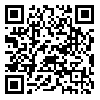Volume 6, Issue 1 (Continuously Updated 2023)
Func Disabil J 2023, 6(1): 0-0 |
Back to browse issues page
Download citation:
BibTeX | RIS | EndNote | Medlars | ProCite | Reference Manager | RefWorks
Send citation to:



BibTeX | RIS | EndNote | Medlars | ProCite | Reference Manager | RefWorks
Send citation to:
Kazemi H, Kamali M, Salehi R, Mobaraki H. Recognizing the Viewpoint and Experience of Blind People in Navigation and Daily Traffic. Func Disabil J 2023; 6 (1) : 236.1
URL: http://fdj.iums.ac.ir/article-1-199-en.html
URL: http://fdj.iums.ac.ir/article-1-199-en.html
1- Department of Rehabilitation Management, Faculty of Rehabilitation Sciences, Iran University of Medical Sciences, Tehran, Iran.
2- Department of Rehabilitation Management, Faculty of Rehabilitation Sciences, Iran University of Medical Sciences, Tehran, Iran. ,kamali.mo@iums.ac.ir
2- Department of Rehabilitation Management, Faculty of Rehabilitation Sciences, Iran University of Medical Sciences, Tehran, Iran. ,
Abstract: (1763 Views)
Background and Objectives: One of the most obvious problems faced by the blind is the inability to navigate properly. Safe and independent urban navigation is difficult for visually impaired people. According to the international classification of functioning, disability, and health (ICF), the health and illness status of a person is measured by the structure and function of the body, limitations in performing activities, and the person’s participation in society. Individual factors and environmental factors affect a person’s activities, and these activities affect a person’s participation in society. For this reason, the present study was conducted to investigate the individual factors that blind people use in their daily traffic.
Methods: In this qualitative study, 12 blind people, 1 person with severe visual impairment, and 1 sighted person were selected using the snowball sampling method to participate in the study. Information was collected through in-depth and semi-structured interviews. The conventional content analysis method was used for analysis and the data triangulation method was used to validate the findings.
Results: After analyzing the statements and classifying the extracted codes, 4 sub-themes were obtained, including “learning the route”, “reluctance to travel”, “helping others”, "using environmental signs” and from the integration of these sub-themes, the theme “daily traffic” appeared.
Conclusion: The present study showed that blind people use similar strategies in their daily traffic. These solutions include keeping the path, traveling on familiar paths, using environmental signs, and getting help from others. Reasons, such as fear of the environment, fear of injury, and the family’s unwillingness to leave are an obstacle to the independent movement of the blind person.
Methods: In this qualitative study, 12 blind people, 1 person with severe visual impairment, and 1 sighted person were selected using the snowball sampling method to participate in the study. Information was collected through in-depth and semi-structured interviews. The conventional content analysis method was used for analysis and the data triangulation method was used to validate the findings.
Results: After analyzing the statements and classifying the extracted codes, 4 sub-themes were obtained, including “learning the route”, “reluctance to travel”, “helping others”, "using environmental signs” and from the integration of these sub-themes, the theme “daily traffic” appeared.
Conclusion: The present study showed that blind people use similar strategies in their daily traffic. These solutions include keeping the path, traveling on familiar paths, using environmental signs, and getting help from others. Reasons, such as fear of the environment, fear of injury, and the family’s unwillingness to leave are an obstacle to the independent movement of the blind person.
Article number: 236.1
Type of Study: Research |
Subject:
Emergency Preparedness
Received: 2023/01/25 | Accepted: 2023/03/4 | Published: 2023/02/6
Received: 2023/01/25 | Accepted: 2023/03/4 | Published: 2023/02/6








